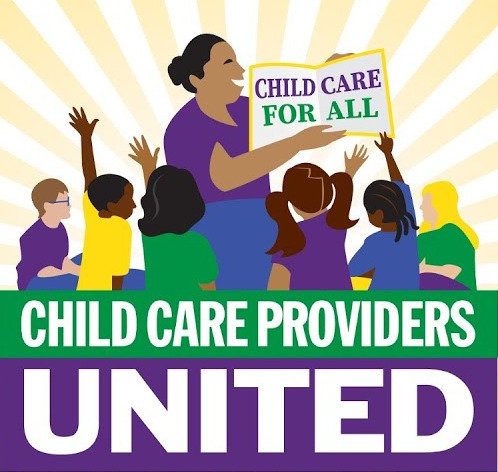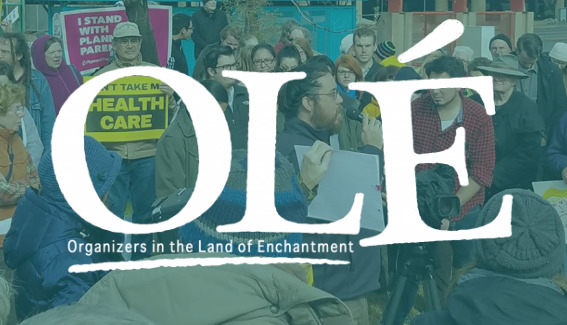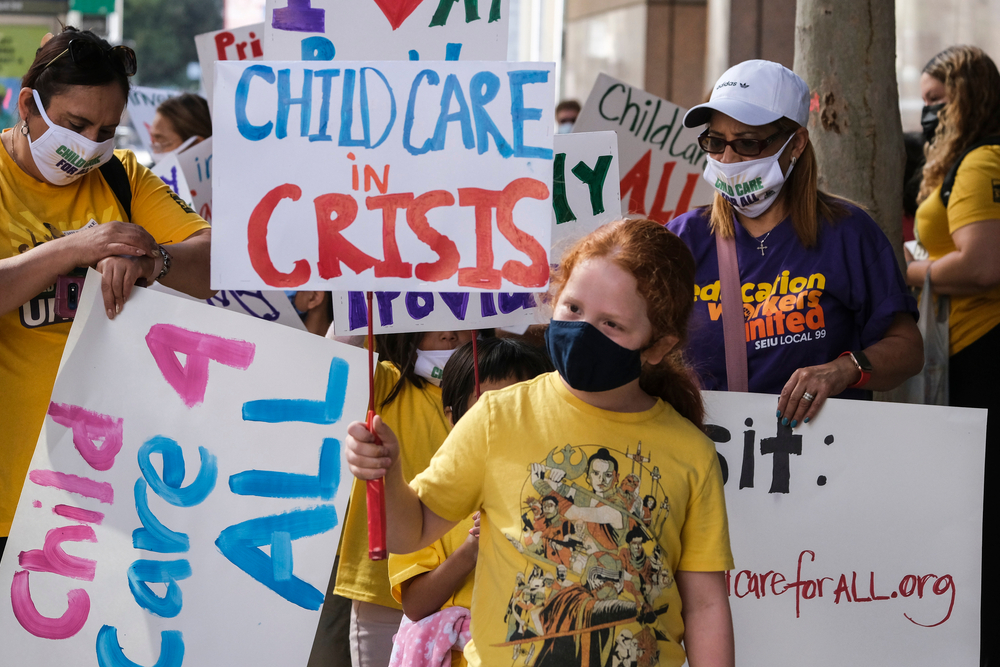The pandemic underscored the stark differences in pay, working conditions, and respect between K-12 educators and child care teachers in many communities. The disparity is rooted in race, class and gender: Child care teachers are more likely to be female, less likely to be white, and more likely to come from lower-income backgrounds than public school teachers.
In spite of historically poor treatment and low pay, child care workers have been exceptionally hard to unionize, due to high turnover rates, the geographic spread and isolation of the workforce, labor laws, and other factors.
California and New Mexico offer two examples of successful advocacy work
 Yet there have been union victories in recent years. In California, Child Care Providers United, which represents more than 40,000 home-based providers, won the right to collective bargaining in 2019, and last year secured a second substantial reimbursement increase from the state for many home child care providers.
Yet there have been union victories in recent years. In California, Child Care Providers United, which represents more than 40,000 home-based providers, won the right to collective bargaining in 2019, and last year secured a second substantial reimbursement increase from the state for many home child care providers.
In New Mexico, where it’s harder for employees to unionize, organizers have taken a different tack: Through the leadership of an organization called OLÉ [standing for Organizers in the Land of Enchantment], parents and child care teachers joined forces to organize a public awareness campaign which contributed to voters approving a constitutional amendment guaranteeing a right to free child care for most of the state’s families.
I spoke earlier this month with Alexa Frankenberg, executive director of California’s Child Care Providers United, and Brenda Parra, senior digital strategist for OLÉ about how to effectively organize child care workers and the importance of diverse strategies for doing so.
The Conversation
This conversation has been edited for length and clarity.
Hechinger Report: Can you tell me about your personal background and how you became involved in the field?
 Brenda Parra: It’s been maybe six or seven years. I used to be a child care worker. I was in a classroom with 3-year-olds and I had to leave my position, unfortunately. I really loved doing the work, but the pay was very low and it was not supporting my family anymore. Somebody told me about OLÉ, which was doing child care organizing at the time. So I started joining these meetings. And I stuck around for a while until I decided to become an organizer.
Brenda Parra: It’s been maybe six or seven years. I used to be a child care worker. I was in a classroom with 3-year-olds and I had to leave my position, unfortunately. I really loved doing the work, but the pay was very low and it was not supporting my family anymore. Somebody told me about OLÉ, which was doing child care organizing at the time. So I started joining these meetings. And I stuck around for a while until I decided to become an organizer.
What have you learned about what makes organizing effective in the child care space?
Alexa Frankenberg: One of the things that makes it uniquely challenging is just how dispersed the family child care providers are. They obviously work in their own homes so there are tens of thousands of work sites around the state for the members that are represented by CCPU (Child Care Providers United). That means you need to figure out how to have conversations with people spread over [many] work sites about how organizing together to build power through a union can make a difference in their lives.
Another challenge relates to the low pay. Many child care providers and staff have to hold multiple jobs to be able to make ends meet and support their families. So it’s a challenge for them to find the time to have the conversations, do the organizing work, and work together to make change. That takes time.
Thinking about the success that you’ve had in California, what were some specific strategies that you used there to try to overcome some of these challenges?
Parra: There’s work you can do in terms of systematically identifying and recruiting leaders, equipping them to do the work. You’re never going to be able to have the resources to staff a campaign to go to 50,000 work sites to talk to folks. That requires you to think early on about individuals leading and owning this work, including talking to their coworkers.
When OLÉ first started its work, what was its strategy?
Parra: From what I am aware, OLÉ started door knocking and organizers used to go to centers and, once there, they would talk to the director and ask if they could talk to their teachers and their parents.
How did strategies evolve over time?
Parra: The digital work ramped up during COVID. It was super hard to be able to find child care because of the circumstances of COVID and everyone getting sick. There were a lot of centers closing down. We were running ads on social media. We were able to get further out there and get people more informed. When we started doing online organizing, we would get maybe a week’s worth of work visiting centers done in one day.
Thinking of New Mexico, and OLÉ’s success at making inroads for child care teachers outside unionization, how important is it to think about other strategies apart from traditional organizing?
Frankenberg: I don’t think it has to be either-or. We have worked side by side with allies, such as parent advocates and others, here in California. And that has been part of what has allowed us to be successful, both at the state level as well as local level. We worked super closely with parent voices in Alameda County to win passage of a local measure to fund additional child care slots, higher pay and other supports that are needed. We continue to look to New Mexico for the work they’ve done to move to alternative methods. We obviously think that there’s some really critical and important guarantees that a union contract allows providers to have, but organizing and collective power take a lot of different shapes.
How have you been able to translate online organizing in New Mexico into concrete victories for child care workers?
Parra: My work is to put up the online ad and collect the phone number and name of the person who responds. After that, I will put it into either a phone bank or a text bank so one of the organizers from the early education campaign can send them a text or get more information from them.
Do you feel the pandemic made it easier or harder to organize in the child care space?
Frankenberg: That’s a hard question to answer because there’s nothing about the pandemic that was easy. What these individuals went through — financially, physically, mentally, emotionally — all these things are still being felt. So it would be really hard to say it made things easy. What it did was make consequences very stark. It was very clear that there was work that was needed to ensure basic health and safety of individuals. We had to fight for COVID closure days so that people could close down and not lose money because they had COVID or someone in their child care had COVID.
[Related: Daycare owners and parents say they are at a breaking point as federal relief funds end]
The pandemic shone a spotlight on the value of child care to allow people that needed to go to work to go to work in those first few months, particularly when schools closed. Child care workers were holding up our economy for a long time. And they’ve never had a break, really.
What do you feel the future holds for child care organizing?
Frankenberg: We’re in the middle of moving to cost-of-care reimbursement, which is something they’ve achieved in New Mexico. That’s a big thing on the horizon for us. There are a lot of short-term gains we’ve been able to make on pay. And it’s critical that we don’t continue to just go short-term to short-term to short-term, but really move towards a system. We’re glad to have the governor’s partnership on this. And we’re working toward ensuring people are receiving more than pennies on the dollar.
[Related: Utah bills itself as “family-friendly” even as lawmakers have long neglected child care]
We need to make sure that the child care system that we have is one that really reflects who California is in the year 2024, not a system that was set up 50 years ago and may have some of those biases. We need to root out the racism, the sexism, that’s inherent in the system. It’s baked into the pay and compensation, but it’s also baked into really unjust policies that have negative impacts on families and providers.
***
Sarah Carr has reported and edited for Hechinger since 2011. Currently, she covers early childhood education and manages the eight-newsroom Education Reporting Collaborative. She has written for The Washington Post, The Atlantic and Slate, winning several national awards.
This story about child care advocacy was produced by The Hechinger Report, a nonprofit, independent news organization focused on inequality and innovation in education. Sign up for the Hechinger newsletter.




























